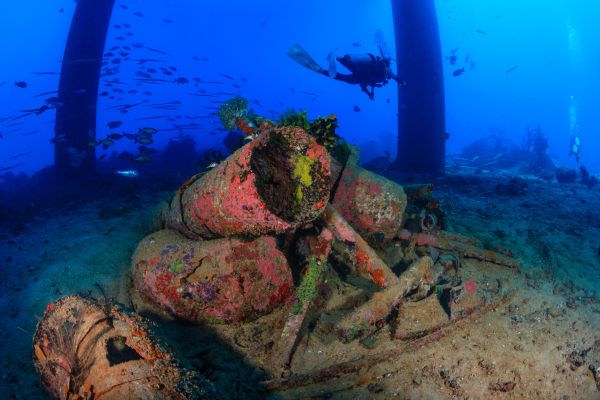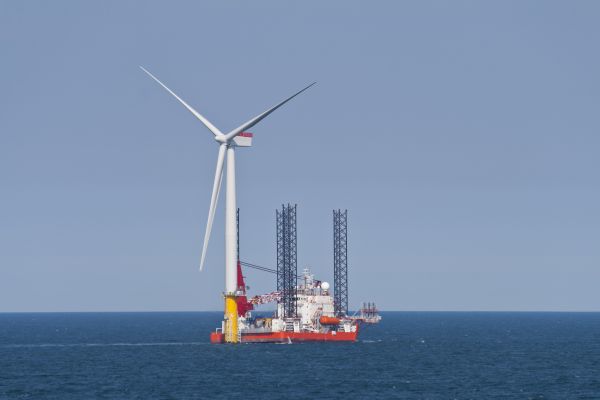That's exactly what Netherlands-based Fistuca are doing with their ground-breaking BLUE Piling technology. And Vysus Group’s noise experts are helping to take it from a prototype to a commercial reality
Construction of offshore wind turbine foundations is mostly done via pile driving using hydraulic hammers. These hammers typically consist of a steel ram weighing around 150-200 tonnes which impacts onto the pile top to drive it down.
Not surprisingly, this is extremely noisy, and big efforts must be made in order to reduce the underwater noise. Effective noise mitigation strategies and tools at a cost of around 40million Euros per windfarm (according to data published in Germany recently), must be employed. The high costs cause an interest to driving down the cost of the noise mitigation measures when installing offshore wind farms
It's simple really: just water, gas in a steel housing with an internal combustion chamber
In 2011 Fistuca started to look into a new concept for impact driving of monopiles: BLUE Piling. After a testing phase (in which four prototypes were tested over over four years) the company, led by Jasper Winkes and with support from Huisman Equipment and the Dutch Government, started work on a fully developed model which, when completed, will be the largest hammer in the world, the BLUE 25M.
Unlike conventional hydraulic hammers, Fistuca's BLUE Hammer uses the acceleration of a water column by combustion of a gas mixture to drive the pile into the ground. A combustion cycle pushes the water column in the air after which it falls back on the pile, delivering a second blow.


One new technology – and a whole host of benefits
Essentially, the BLUE Hammer replaces the steel ram with a big volume of sea water – in turn replacing the loud "metal-on-metal" impact to the comparatively more silent impact of "water-on-metal". The noise from the water impact is furthermore concentrated at lower frequencies. The physics of shallow water acoustics cause reduced noise propagation at these frequencies. This gives the BLUE Hammer a natural low-noise advantage.
Furthermore, whilst a relatively large amount of energy is delivered to the pile, the process of the combustion and rebounce of the water column is relatively slow and has far less impact on the monopile. This more gradual increase in force onto the pile head introduces less material stress in the pile. This is a more gentle way of pile driving, and can potentially result in longer lifetime of the foundation, and the possibility of driving a pile with secondary steel attached to the pile.
An offshore technology that can reduce the noise at source as well as extend asset life has huge game changing potential, and the computer modelling based on the prototype suggested promising results. Any model is only as good as its assumptions - and novel technologies rely on those a lot.
Whilst a relatively large amount of energy is delivered to the pile, the process of the combustion and rebounce of the water column is relatively slow and has far less impact on the monopile.
Methodology and maths - testing the assumptions
To progress the technology towards mainstream development, Fistuca needed to test and validate the assumptions. As Jasper Winkes explained, "It's a new technology in an industry that knows prices need to come down. You can't expect results immediately so most operators feel safer by sticking with what they know. We need to demonstrate that the BLUE Hammer could meet the most stringent noise pollution regulations, which are in Germany."
Fistuca asked Vysus Group’s Engineering Dynamics team (based in Copenhagen) to help with this. We looked at scaled input test data and performed numerical simulations of the expected underwater noise from the prototype device during operation. According to our simulations, this has the potential to produce far less noise than the ordinary, hydraulic hammers. Whether that full potential is exploited is yet to be demonstrated in a full-scale trial at sea of the BLUE Hammer.
Jasper Winkes said, "We achieved valuable data from our reduced scale measurements. The Vysus Group team was then able to combine the lab data with a carefully adapted vibro-acoustic model.
This has become a very valuable prediction tool for us and it will continue to improve as we gather more offshore data. It's not only relevant for us, but for the utility companies we're talking to who need to have a high degree of confidence in underwater noise propagation predictions."
What's next?
Fistuca are currently planning an offshore test with the hammer, which they anticipate will fully evidence the benefits. At the same time, they are working with a number of utilities with a view on full-scale deployment in the next few years. Although Europe is the company's home ground and key territory at present, in the longer term Blue Piling technology could potentially be deployed across the global sector and become the leading pile driving tool worldwide.
Vysus Group's Renewable energy experts regularly share their knowledge and learnings in order to advance the growth of low carbon energy.
Related Services
